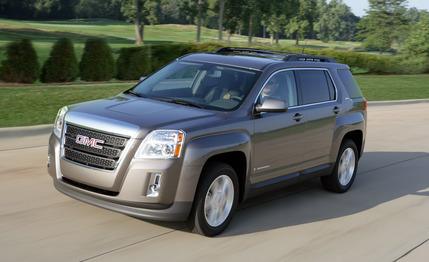
 First Drive Review
First Drive Review
While the General is in the process of honorably discharging half of its global brands, its remaining army must hold down the fort in an automotive battleground only marginally less vast than in prerecession days. This means that each of the four remaining GM brands will see an expansion of duties, including heretofore truck-only GMC, which, for the first time in its 107 years, has not one but two crossover offerings: the three-row, eight-passenger Acadia and now the smaller, five-passenger Terrain.
Equinox in a Tux
Built using the same dirty parts as those of the well-received 2010 Chevrolet Equinox, the Terrain at once provides customers with a different choice of small-crossover garb and plunks a much-needed two-row crossover into Buick/GMC dealerships. Is the Terrain significantly different from the Equinox? Other than its styling and pricing structure, not really. That’s a good thing, because, well, the Equinox is a good thing. In recent reviews, we have praised its assembly quality, ride composure and quietness, and highly designed, tech-filled interior.
Thus, choosing between the Chevy and the GMC boils down to which you consider to be better-looking. Sharing only the windshield and a few other ancillary bits (such as door handles) with the Equinox, the Terrain is crisp and boxy where the Equinox is curvy, yet to most eyes that have seen it in person, the Terrain’s styling works just as well. Surprisingly, the blunt shape has the same coefficient of drag as the previous-generation Corvette’s. If there is anything that might stir up controversy about the design, it’s the dominant grille, followed by the squared-off wheel openings—both of which tie the Terrain to other GMC offerings but don’t work as well on the Terrain. Other than those, there’s little any of us find disagreeable.
Ditto inside. All Terrains come with unique upper-dash designs, gauges, graining, and red contrasting stitching. The futuristic center-stack controls are shared with the Equinox, although nighttime illumination—which includes lights for cubbies, floor areas, and door pulls—is rendered in red and white versus the Chevy’s ice blue.
Identical Road Manners
Being twins under the skin, the Terrain and the Equinox are virtual clones in the road manners department. The 182-hp four-banger revs happily and sounds surprisingly good at full throttle, although the optional V-6’s beefier power band enhances everyday drivability. Neither engine makes the Terrain terribly fast, but both are exceedingly smooth and are paired with six-speed automatics that feature a thumb-shifting rocker switch on the console-mounted shift lever. Noteworthy, however, is that V-6 models come with a hydraulically based steering system versus the electric system of the four-cylinder models, the former offering much better feedback, not surprisingly. The most glaring dynamic shortcoming is a brake pedal that feels as precise as a hand mixer in a pot of mashed potatoes.
Neither Cheap Nor Pricey
Besides styling, the other primary difference between the Equinox and the Terrain is one of pricing structure. Without getting into an arduous bit-by-bit price comparison with the Equinox, the Terrain is roughly $1800 more expensive to start. For the Terrain SLE1’s $24,995 base price (versus the base Equinox’s $23,195), that extra dough includes standard tinted glass, fog lamps, floor mats, a USB port, and a backup-camera display housed in an auto-dimming rearview mirror. Expect a slight price premium to remain when moving up the ladder to SLE2, SLT1, and SLT2 trim levels.
Options themselves are quite reasonably priced, but there are a lot of them that can take the price of a loaded Terrain well into the upper-$30,000 range. The gutsy V-6 is only a $1500 upgrade; a dual-screen DVD entertainment system is $1295; the trailering package costs $350; chrome-clad 19-inch wheels are $900. Add all that onto the top-shelf SLT2 model, along with the available touch-screen navigation system ($2145) and all-wheel drive ($1750), and the price climbs to nearly $38,000, which seems either reasonable or extreme, depending on what you are cross-shopping it against. If you see the Terrain as an alternative to a nice Honda CR-V or leather-wrapped Toyota RAV4, à la Equinox, it’s sort of pricey. But if, as does GMC, one sees it as competing with loaded mid-sizers like the Nissan Murano and Ford Edge, the Terrain is midpack to bargain-priced.
Don’t be surprised to see an even pricier Denali model enter the picture sooner rather than later, equipped with things like LED lighting, premium materials, and real wood trim. That model should reinforce GMC’s upscale positioning and further differentiate the Terrain from the Equinox, although it would run the risk of standing on sales of the newly introduced Cadillac SRX. Meanwhile, what GMC offers with the Terrain is certainly a respectable, credible, and slightly upscale alternative to the Equinox.